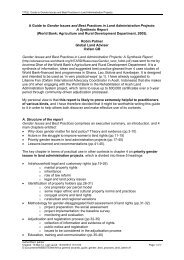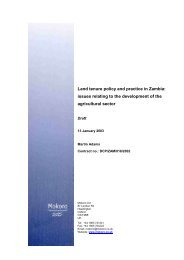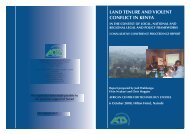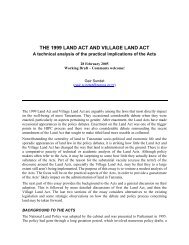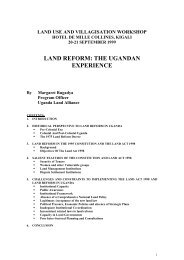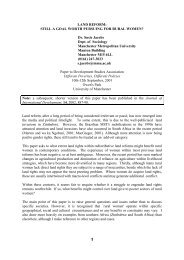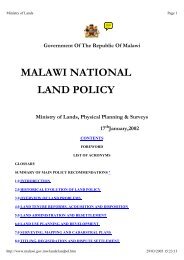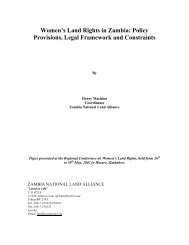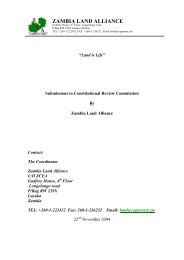Download - Mokoro
Download - Mokoro
Download - Mokoro
- No tags were found...
Create successful ePaper yourself
Turn your PDF publications into a flip-book with our unique Google optimized e-Paper software.
46requirements) and link this with infrastructure that supports these existing farmingtypes;Market environment: input and output markets and value chains – how do theseshape production and what kinds of production can be profitable, given this marketenvironment? What interventions in the market environment can expandopportunities for profitable small-scale farming by the poor?Need / demand: it should be possible to categorise areas of greatest land need, onthe basis of survey data, area-based planning processes, population densities incommunal areas, eviction hotspots, and areas with a density of farm dwellers,particularly where they are involved in some production of their own, such as inKwaZulu-Natal, Limpopo and Mpumalanga.Different kinds of information will be needed to inform agrarian reform and monitor itsimpact in the future. Three points can be made. First, it will be essential to captureproduction, land use and income data for land reform areas and the communal areaswithin the national agricultural statistics, and ensure that these can be extracted forseparate analysis. This is essential for two reasons: first, to make visible production thathas been excluded from official statistics – therefore distorting information about theagricultural sector; and second, in order to compare the production of smallholders andresource-poor producers with production in the mainstream of commercial agriculture.This must capture all production, not only that which is sold, since for the poor thegreatest value of production may be in consumption – and the economic importance ofthis should not be excluded from view. Second, what is needed is the monitoring of thecontradictory trends of concentration and redistribution in land ownership – a Gini coefficientfor the distribution of agricultural land. Third, government should reintroduceland classification for regional planning and mapping, so that planning within politicalterritories (districts) can be related to planning for agro-ecological zones.7.2. Rural people’s visions for land and agrarian reformWhat is known about the land use priorities of black South Africans living in rural areaswho are poor – and the implications for how production can be organised andsupported? Available survey data do not address land use in detail but suggest that thevast majority of rural people indicating a need for land want small areas of land, with astrong preference for land close to where they stay currently. 4During this project, PLAAS co-hosted with rural NGOs a series of six consultativeworkshops with rural people were held to elicit reflections on existing experiences and todevelop a vision for what rural people would like to see as the outcome of land andagrarian reform. The workshops included a wide array of poor black South Africans,including restitution claimants, farm workers, farm dwellers and labour tenants,commonage users, LRAD beneficiaries and applicants, small farmers, people living insmall rural towns, residents of communal areas in the former black and ‘coloured’‘homelands’, people living on Transnet and forestry land, members of agriculturalcooperatives, many of whom were representing formations or associations, as well as4 See the first paper in this series for a review of these surveys by the Land and Agriculture PolicyCentre (LAPC), Human Sciences Research Council (HSRC), Institute for Justice andReconciliation (IJR) and Centre for Development and Enterprise (CDE).Policy Options for Land and Agrarian ReformProgramme for Land and Agrarian Studies, University of the Western Cape




